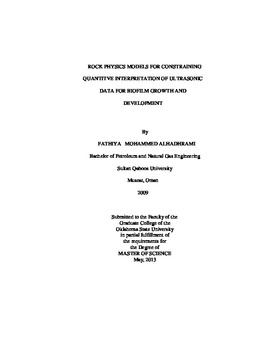| dc.contributor.advisor | Jaiswal, Priyank | |
| dc.contributor.author | Alhadhrami, Fathiya Mohammed | |
| dc.date.accessioned | 2014-09-24T14:17:53Z | |
| dc.date.available | 2014-09-24T14:17:53Z | |
| dc.date.issued | 2013-05-01 | |
| dc.identifier.uri | https://hdl.handle.net/11244/11061 | |
| dc.description.abstract | This study examines the use of rock physics modeling for quantitative interpretation of seismic data in the context of microbial growth and biofilm formation in unconsolidated sediment. The impetus for this research comes from geophysical experiments by Davis et al. (2010) and Kwon and Ajo-Franklin et al. (2012). These studies observed that microbial growth has a small effect on P-wave velocities (VP) but a large effect on seismic amplitudes. Davis et al. (2010) and Kwon and Ajo-Franklin et al. (2012) speculated that the amplitude variations were due to a combination of rock mechanical changes from accumulation of microbial growth related features such as biofilms. A more definite conclusion can be drawn by developing rock physics models that connect rock properties to seismic amplitudes. The primary objective of this work is to provide an explanation for high amplitude attenuation due to biofilm growth. The results suggest that biofilm formation in the Davis et al. (2010) experiment exhibit two growth styles: a loadbearing style where biofilm behaves like an additional mineral grain and a non-loadbearing mode where the biofilm grows into the pore spaces. In the loadbearing mode, the biofilms contribute to the stiffness of the sediments. We refer to this style as "filler." In the non-loadbearing mode, the biofilms contribute only to change in density of sediments without affecting their strength. We refer to this style of microbial growth as "mushroom." Both growth styles appear to be changing permeability more than the moduli or the density. As the result, while the VP velocity remains relatively unchanged, the amplitudes can change significantly depending on biofilm saturation. Interpreting seismic data from biofilm growths in term of rock physics models provide a greater insight into the sediment-fluid interaction. The models in turn can be used to understand microbial enhanced oil recovery and in assisting in solving environmental issues such as creating bio-barriers to prevent water contamination or CO2 leakage. | |
| dc.format | application/pdf | |
| dc.language | en_US | |
| dc.publisher | Oklahoma State University | |
| dc.rights | Copyright is held by the author who has granted the Oklahoma State University Library the non-exclusive right to share this material in its institutional repository. Contact Digital Library Services at lib-dls@okstate.edu or 405-744-9161 for the permission policy on the use, reproduction or distribution of this material. | |
| dc.title | Rock Physics Models for Constraining Quantitve Interpretation of Ultrasonic Data for Biofilm Growth and Development | |
| dc.type | text | |
| dc.contributor.committeeMember | Atekwana, Estella Akweseh | |
| dc.contributor.committeeMember | Atekwana, Eliot Anong | |
| osu.filename | Alhadhrami_okstate_0664M_12770.pdf | |
| osu.accesstype | Open Access | |
| dc.description.department | Geology | |
| dc.type.genre | Thesis | |
